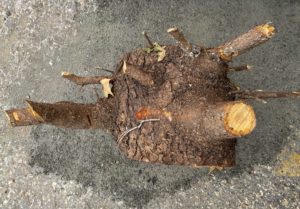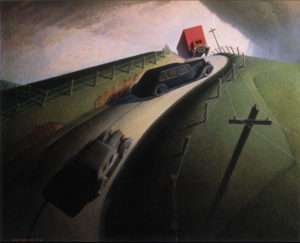
We collected this log from the curb by 5 Turner Alley, aka Grant Wood’s studio.
We have envisioned this “page” in the codex as a re-imagining of his famous painting Death on Ridge Road, typically viewed as an impending car wreck about to kill the people inside the vehicles. But to the side of the road, looming over the cars, stands a utility pole: a pole made of wood—wood that was once a tree.

Death on Ridge Road by Grant Wood, 1935, Williams College Museum of Art. Public domain, United States, author’s life plus 70 years. Fair use for educational purposes.
That tree is a victim, too: of our need for phone lines and electricity. The coal burned to produce electricity at the time polluted the air with mercury and lead, which is contained within tree rings — literally, air pollution made flesh. If sliced and examined, that utility pole may have contained in its rings (depending on when it was chopped down) the pollutants produced to generate the electricity that traveled through the wires it held up. Agriculture destroyed the natural prairie, and runoff pollution poisons our water and the oceans. The cars, too, are made from metals mined from the earth—a highly destructive and polluting extraction process. Pollutants from the fuel for those cars have led us here, to this moment, in the wake of derecho. It all comes full circle.
For our re-imagining, we will recast the truck turning around the curve as an ADM ethanol tanker, and the car careening into its path? A Tesla. The third vehicle: A claw truck loaded with logs and picking up the downed utility pole (wood becomes a tree again, full circle). The field to the right: corn mowed down by the high winds. Here, we shift focus so it’s not only the humans inside the vehicles who are victims, but also the trees and crops (though crops also victimize the natural flora and fauna, so they are perhaps somewhere in between victims and perpetrators, as we are, too).
And if you look closely, you will see a storm approaching on the edge of Grant Wood’s painting: the derecho was always a threat; like the driver about to be hit by the truck, we just didn’t see it coming.
Grant Wood’s painting depicted a clash between the urban and the rural — and in Grant Wood’s time, a clash between New York and the Midwest Regionalists attempting to found the Midwest school. Our re-imagining depicts two clashes: first, between modern life and the survival of the very land that created the Regionalist aesthetic; second, the politics of disaster in the Anthropocene. After derecho, Iowa was subject to mockery and scorn from urban centers for being a rural, red state in crisis, even though the big cities depend on our agricultural production (and even though many of us do not vote “red,” and the hardest-hit residents were marginalized people, including refugees, in a blue county). So rather than viewing the painting within the ecosystem of the art world, we are viewing it within the ecosystem of the larger world, both natural and political.
